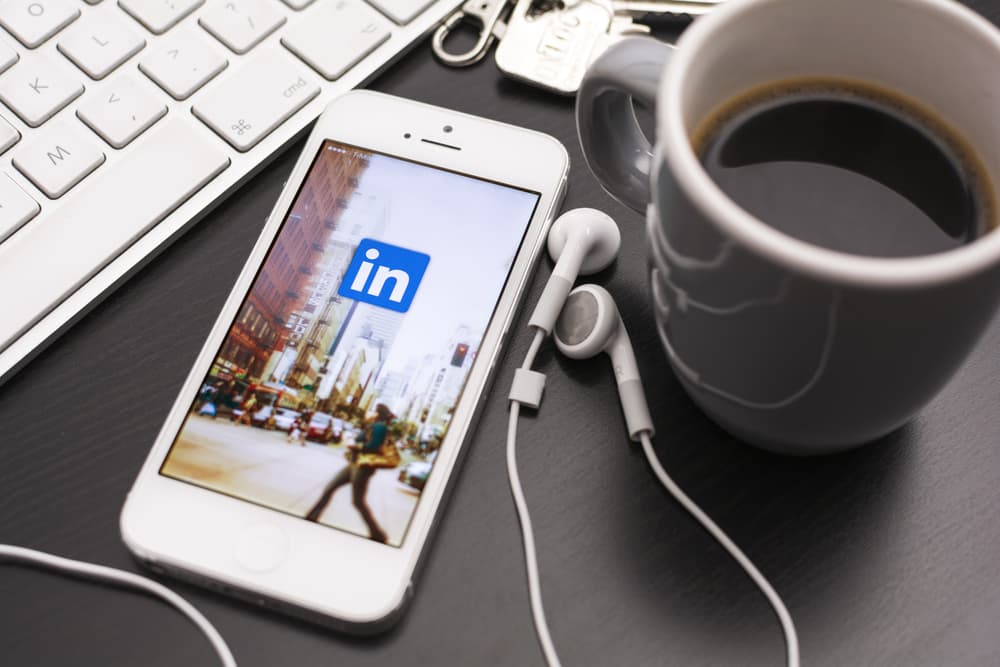Business News Daily provides resources, advice and product reviews to drive business growth. Our mission is to equip business owners with the knowledge and confidence to make informed decisions. As part of that, we recommend products and services for their success.
We collaborate with business-to-business vendors, connecting them with potential buyers. In some cases, we earn commissions when sales are made through our referrals. These financial relationships support our content but do not dictate our recommendations. Our editorial team independently evaluates products based on thousands of hours of research. We are committed to providing trustworthy advice for businesses. Learn more about our full process and see who our partners are here.
What Is LinkedIn? How to Use It Personally and Professionally
LinkedIn and make the most of its features, both as a professional and as a small business.

Table of Contents
What is LinkedIn?
LinkedIn is a social network for the business community. Founded in 2002, the site is a place for professionals to connect with past and current colleagues, increase business connections, network within their industry, discuss business ideas, search for jobs and look for new hires.
LinkedIn users create professional, resume-like profiles that allow other site members to learn more about their business background, areas of expertise and professional development organization memberships. Once users create a profile, they can add other users to their network.
The profiles also include status updates that let people in a user’s network know what they’re working on and when they might be traveling for business. There is also a feature that allows people who are not signed in to LinkedIn to view parts of a user’s public profile.
LinkedIn business profiles are for organizations seeking to hire, generate leads, grow and market their business, and more. LinkedIn also offers solutions and resources for businesses of all sizes.
We’ll explore LinkedIn’s various tools and resources for both individual professionals and businesses.
LinkedIn’s main features
While the LinkedIn platform incorporates numerous features and solutions for individuals and businesses, its primary and most-used features include the following.
- Keeping in touch: People often change jobs and find new opportunities. LinkedIn allows users to stay updated on where the people in their professional network are working and how to contact them.
- Getting help: When a user’s network of contacts can’t help with a business problem, LinkedIn Groups help the user connect with experts through trusted introductions.
- Searching for jobs: LinkedIn’s job search feature lets users access thousands of employment listings, with options for filling out applications directly on the site. The application and the user’s LinkedIn profile are sent directly to potential employers.
- Hiring new employees: Hiring managers can use LinkedIn to find candidates with in-demand career skills and appropriate experience.
What are the personal features of LinkedIn?
When you’re new to LinkedIn, it’s easy to overlook some of its valuable features for personal users. First, you’ll need to create a profile. Think of it as your professional resume.
From there, you can write blog posts, share commentary on articles, and join LinkedIn Groups. You can even search for jobs or sign up as a freelancer.
Using LinkedIn Pulse, you can post thought leadership articles or status updates to gain a stellar reputation among your industry peers. This news aggregation service gathers high-quality articles from major media outlets mixed with posts from LinkedIn users.
Also, consider asking co-workers, clients and colleagues for skill endorsements on LinkedIn. These endorsements act as recommendations for potential employers. You’re in control of what you share.
What is LinkedIn for Business?
LinkedIn for Business lets you create a business profile for your organization. From there, you can create job postings, search through profiles to learn about potential clients and vendors, and much more.
LinkedIn is an enormous platform that lends itself to marketing, especially for B2B businesses. In 2016, Microsoft — which has long catered to enterprise users — acquired LinkedIn.
Because it’s built for professionals, LinkedIn is a great lead-generation platform. You can target potential clients by industry, company, job title and more to reach the people who matter most to your business.
Is LinkedIn free?
LinkedIn is free for a basic membership, but your options are limited. You can only send messages to people in your network, and you will have access to limited data on the last five people who viewed your profile. Searches are limited to 100 results, and you can’t perform more advanced searches.
Still, a free LinkedIn membership has the benefit of including you among your professional peers. A free LinkedIn account allows you to create a portfolio, add people to your professional network, join and create groups, and write blog posts.
A free LinkedIn membership is an excellent way for beginners to gain exposure to a broader professional audience.
What are LinkedIn Groups?
LinkedIn Groups help users make connections with others in the same industry, as well as their overall network. Groups provide opportunities to ask questions, build relationships, and engage in conversations about each user’s brand or professional standing.
LinkedIn Groups are designated private spaces to view, post and comment on conversations with other group members. Only those invited to the Group can see and interact with posts, though each Group can set specific parameters for admission. Additionally, users within the same Group can send message requests to start chatting.
Here’s how to get the most out of LinkedIn groups:
- Be patient. Like Facebook Groups, LinkedIn Groups are communities, some of which are tightly knit and lead to real-life relationships. Becoming a part of them may take time. If you jump in too quickly, your connection could feel artificial, discouraging others from working with or referring you in the future.
- Introduce yourself. Your initial introduction doesn’t have to be long, since your profile should speak for itself. Still, ideally, you should include a welcome greeting (“Hello, I’m happy to be here”), an explanation of your trade (“freelance graphic design in the fashion industry”), and a call to action (“feel free to connect if you work in the fashion industry”).
- Browse previous posts. Get a grasp of the group climate before making a post, and especially before asking for help. Otherwise, you might burn some bridges before you even get to cross them. Plus, getting a feel for the group climate can determine how much time you’re dedicating to churning connections. For instance, it’s easy to see if a group is inactive or full of spammers from clicking through different posts, which only takes a few minutes.
How to use LinkedIn for hiring
LinkedIn is one of the top destinations for job seekers. Recognizing the central role it plays in connecting aspiring employers and employees, LinkedIn has revamped its hiring tools to build a streamlined pipeline for applicants and leads. It has combined a large batch of existing tools into a comprehensive set so hiring managers can recruit the best talent.
Using LinkedIn Skill Assessments to find the right fit
One of the most valuable features is LinkedIn Skill Assessments, which help job seekers and recruiters. These are some of the program’s most valuable features:
- It helps job seekers stand out from the pack. Participating in Skill Assessments can help users become more popular among recruiters and hiring managers. Company reps say the feature allows members to “build a stronger profile” that helps them stand out from the pack.
- Job seekers will show up in more searches. LinkedIn claims it will make candidates who have completed a Skill Assessment more likely to appear in searches.
- Job seekers will receive job recommendations. Anyone who passes an assessment for an in-demand skill will receive relevant job recommendations as soon as they’re available.
- It streamlines the candidate search for recruiters. Through Skill Assessments, recruiters and hiring managers can streamline the candidate search. Employers won’t have to set up custom assessments to prove a candidate’s abilities. Instead, they’ll be able to find out at a glance who passed a LinkedIn Skill Assessment and go from there.
- Recruiters can send assessments to applicants. Recruiters will also be able to send applicants assessments to complete. It won’t be mandatory, but it will help candidates stand out. If an applicant takes an assessment but does not pass, that won’t be visible to the recruiter.
Attracting and retaining high-quality candidates
Since the current market is driven by candidates rather than employers, hiring managers must understand how to attract and retain high-quality candidates. Here are some useful LinkedIn tips and tools:
- Be transparent about your workplace. According to 2021 data from Glint and LinkedIn, about 87 percent of workers prefer a remote workforce or hybrid work setting. Be upfront with candidates about the type of workplace you’re offering so they can find the role that suits their needs or priorities.
- Search candidates based on preferences. You can also search directly for candidates based on their workplace preferences and reach out to co-workers to help you narrow down your search.
- Use the Recruiter mobile app. Another strategy to use during the hiring process is the Recruiter mobile app. This app notifies you anytime a candidate responds to a message. You can also review applicants’ profiles and search for candidates using the Recommended Matches feature.
How to post a job opening on LinkedIn
Once you know how to use LinkedIn’s hiring and recruiting tools, here’s how to post a job opening on LinkedIn:
- Go to your LinkedIn homepage and select Jobs from the top menu.
- Click Post a Job.
- On the Job Details page, enter your company and job opening information in the Description text box.
- Click the Add Skill icon to include desired skills and expertise.
- Click Continue.
- On the Applicant Options page, choose how you want to be notified about applicants and add screening questions to help identify your top recruits.
- Review the posting and click Post Job when you’re satisfied.
How to display your work with LinkedIn portfolio
A LinkedIn portfolio is a featured section in your LinkedIn profile. Your portfolio contains samples of your work. People who view your profile can look through your samples to get a sense of how you perform your work.
Think about it like this: If your resume tells people what you can do, your portfolio shows it.
Here’s how to showcase your work as a portfolio on LinkedIn:
- Sign in to LinkedIn and go to your profile. To do so, click Me > View Profile.
- In the first box, under your name, click Add profile section.
- Click Recommended > Add featured.
- Click the plus sign and select Add a Post, Add an Article, Add a Link, or Add Media.
- Selecting Add a Post or Add an Article allows you to add any posts or articles you’d like to feature here.
- To add a link to your work, select Add a Link and then paste the URL of the content you want to import. Add a title and description to your link and click Save.
- To add media, select Add Media and choose the file from your computer. Add a title and description to your media and click Save.
Common LinkedIn mistakes
The following mistakes could hurt your chances of making meaningful connections or finding new opportunities on LinkedIn. Avoid these sometimes costly errors.
Not writing your own summary
Rather than having a publicist write a third-person summary of who you are and what you do, write the summary as your genuine, authentic self. Writing in the third person creates distance between you and those reading your summary. They want to know who you are, so show them. When someone else writes your summary for you, it takes away the personal aspect many people hope to encounter.
Having a bad photo (or none at all)
A profile picture allows viewers to connect with you immediately, showing them who you are as a professional. Having a picture can also help them identify you in person at an event or networking opportunity.
If you have no picture, it can be difficult for people to recognize you and make a connection. On the flip side, having an unprofessional picture can be almost as bad as having no picture at all. Unprofessional photos may have bad lighting, other people halfway in the photo, or feature you in an unprofessional setting, such as a party or a bar.
Sending generic invitations
It’s easy for other users to ignore your messages if you use generic language and don’t provide a reason for them to engage. The purpose of using LinkedIn is to connect with others and build your network. You won’t be able to do this if other people’s first impression of you is a half-hearted invitation. Make sure you share why you want to connect, such as having similar groups, shared connections, or an interest in their profile.
Not updating your profile
Users who aren’t active regularly but who suddenly start posting and updating their profile when looking for a new job are making a big mistake. Their boss and colleagues will be able to see the person posting after inactivity and may become suspicious that they’re looking elsewhere for a job.
Consistent activity on LinkedIn will most likely prevent this from happening due to the blend of posts and updates over time.
Misusing LinkedIn’s blogging platform
Anyone can create blog posts on LinkedIn, though a lot of users make the mistake of using this capability to advertise their brand or post a link to something they wrote or created. Instead, the best use of the platform is for users to establish themselves as influential leaders with thoughts that are worth engaging with or exploring.
To create a blog post, go to your LinkedIn homepage. Underneath Start a Post, select Write Article. Select Save after you’re finished.
Join LinkedIn to take advantage for your business
Getting started on LinkedIn is easy. Head to LinkedIn.com and click Join Now on the top right of your screen. The site will walk you through the process of setting up your profile, filling out your portfolio and experience, adding people you know professionally, and joining groups or following interests. From there, you can explore the entire site and start using it to grow your business.
Tejas Vemparala and Max Freedman contributed to this article.













